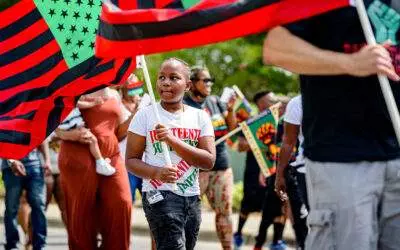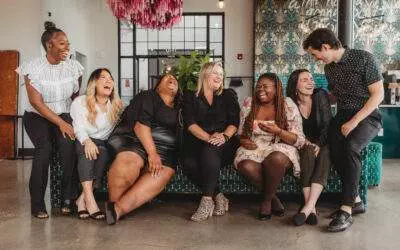In this post, we’ll share some ideas on how to get a diversity committee started at work, and the story of how one of our clients did it–as a case study.
Last year’s Black Lives Matter protests did not emerge out of thin air. Momentum had been building for years by BLM organizers, for decades by civil rights activists, and for centuries by abolitionists and other social justice advocates.
But 2020 was when the U.S. reached a tipping point. Those who had not yet been involved in the racial equity movement could not look away from the injustice of the murders of George Floyd, Breonna Taylor, Tony McDade, and so many others. People who had not been as involved in advocacy efforts joined long-time activists in demanding systemic change.
This energy was not limited to protesters marching in the streets of cities across the country. It also bubbled up within workplaces, with employees calling for company leadership to rise to the occasion (check out our inclusive leadership training course) and asking the hard questions. What are we doing to fight racism in our workplace? Are we treating our employees equitably? What do our leaders have to say on this topic?
Last summer, people3 began receiving dozens of emails and calls from companies that were experiencing enormous interest in racial equity efforts from their employees. They wanted to do something but weren’t sure what the first steps should be.
Most of the time, organizations knew one thing for sure: they didn’t want to exclude the employees who wanted to be involved. This couldn’t be a top-down initiative, nor could it be limited to HR. In other words, they wanted employees to help drive their DEI journey. In many organizations, this took the form of a D&I or DEI or what we call a Diversity, Equity, and Inclusion committee.
Through our work in diversity and inclusion education and consulting, we’ve worked with many such committees in various stages of development. This post will share some ideas on how to get a DEI Committee started at your organization. We will also share a case story on our client, myNEXUS, and their DEI Committee journey.
What is a DEI committee?
DEI committees are small groups of employees (usually around 7-15) from all departments of the organization that take the reins of the DEI journey. They help explain, promote, and encourage the DEI mission. They also have an important role in holding the organization accountable and ensuring the work remains a priority. Some committees play a large decision-making role, while others function more as advisors to leadership. We like to think of committee members as “diversity champions.”
When should DEI committees be formed?
When we first begin working with an organization, we often take a deep dive into understanding all of their layers. We work to understand their demographics, structure, industry, and their challenges in diversity, equity, and inclusion. Depending on the organization’s needs, this may be where we recommend the formation of a DEI committee.
Some companies who reach out to us have already gotten started. They listened to their employees’ call for change and asked, “who wants to lead?.” In some organizations, DEI committees had formed ad-hoc or more like learning communities as a place for employees to discuss diversity, inclusion, and social justice issues. Other companies had such a great response from interested employees that they needed guidance on how to be inclusive in building out the committee while also equipping the committee with the best tools and a strategy.
This was the case with myNEXUS, a mid-sized healthcare company based in Franklin, Tennessee. They reached out to us last summer because they had over 30 people (nearly 10% of their employees) write to Human Resources because they wanted to do something. Having this much interest was ultimately a good problem, and myNEXUS wanted to utilize this strong employee interest to form a Diversity and Inclusion Committee for the organization.
“We want to get something started, but we want to do it the right way.”
-Martee Harris, Chief People Officer at myNEXUS
Getting started with leadership support
The first step in any diversity and inclusion program is to gain leadership support. Ideally, the CEO would champion the committee, but other executive leaders should also be advocates. Strong statements of support from a respected leader demonstrate that this work is being taken seriously, and the organization is committed to change. This not only helps pave the way for the work the committee will do, it also helps create psychological safety by demonstrating that committee members will not face repercussions or risk their job by joining.
Selecting committee members
One of the biggest challenges clients have when forming their DEI committee is determining who should serve as committee members. This can be tricky because organizations don’t want to be viewed as non-inclusive; they want to be as inclusive as possible. However, they also know that a committee of 30+ is too big to be effective. To solve this, people3 takes it out of their hands and acts as the neutral third party to help determine diversity and inclusion committee membership (request a consultation if you’re interested in our help) .
Usually, we’ll create an interest form, which can be sent to all employees. We’ll almost certainly get too many applications (another good problem to have!), so we’ll sort through the forms and make a selection, with three goals in mind.
One goal is to have organizational representation. This goes beyond HR employees as committee members and includes different departments, job types, and job levels. While human resources is a big part of DEI, it is not the only part. DEI work touches every part of the workplace, from hiring to marketing to communication to product design and customer service. (We’ve got some resources for inclusive recruiting and hiring here.)
Another key goal is to have demographic diversity. Often, the committee will be more demographically diverse than the organization, and this is ok. In fact, this acknowledges that not everyone is impacted equally by this work. It also supports our third goal of selection: to include those with either the passion, knowledge, or experience to truly be an effective committee member and not someone who just thinks it’s a cool project for the time being or “just wants to learn.” We need doers. And they have to be dedicated to the work long-term.
For myNEXUS, we received well over 50+ employees who were interested in being a part of their DEI committee. The fact that so many people expressed interest is a positive sign for myNEXUS and signals there are “advocates” among the organization regardless of whether they are on the committee. We narrowed that interest group down to a strong, cross-functional and demographically representative 15-person team. Demographically, the committee had near gender parity and was about 40% White and 60% people of color. While this was more diverse than the organization as a whole (68% white), it was important for the business to center racially diverse voices.
Our client, myNEXUS, had the support of CEO, Juan Vallarino, and COO Matthew Chance, as well as strong HR support, when the process was initiated by Martee Harris, Chief People Officer, and Tyris Williams, Benefits Manager. These leaders were key advocates for the inception of the DEI committee.
“The People3 team is working closely with us to hear the voices of each employee in the myNEXUS family. Starting the program with the People3 team will provide us with insight and guidance to put us on a path to growth and support like we have never seen. D&I is a founding stone of our organization, and for us, good enough will never be good enough…we are excited to continue down the road of teamwork, camaraderie, compassion, understanding, and support for many years to come with People3 helping to support us in that endeavor.”
-Juan Vallarino, CEO of myNEXUS
Dedicating resources
In order for Diversity and Inclusion Committees to be effective, an organization needs to dedicate resources.
The first critical resource is dedicated staff hours. Setting aside time during the workday for committee meetings and tasks demonstrates that this work is valued and does not ask members to dedicate free labor. This work is complex, impactful, and challenging — not something you would ask an unpaid volunteer to do.
A second necessary resource is a budget. There will almost certainly be components that require outside help (such as DEI consulting or training). While committee members are clearly passionate and knowledgeable about diversity and inclusion issues, they may not be facilitators or know how to deliver workshops or be well versed in DEI strategy; thus, outside consulting may be necessary. A committee may also want to pursue operational or infrastructure changes (like updating bathrooms to be gender-inclusive). A dedicated budget, or a mechanism to access funding when needs arise, gives the committee the power to implement their ideas.
This brings us to the third critical resource: power. A DEI committee can spend all the time in the world discussing changes they’d like to see, but without real power to enact those changes, it doesn’t mean much. This will look different for every organization. Some DEI committees will have the power to make and implement decisions themselves; others function more like advisors, giving suggestions to leadership and holding them accountable for change.
Defining roles, responsibilities, and power
Roles will largely depend on the unique goals of your committee. That said, we often recommend that each committee select 1 or 2 chairs who will be responsible for keeping company leadership updated and taking on more planning and decision-making. Chairs will need excellent communication, diplomacy, and strategy skills. They’ll also be the ones with strong drive and motivation, the “let’s do this!” folks.
Other potential roles include note-taker, agenda planner, and facilitator. Committees may wish to rotate these roles so that each person can be fully present without any extra tasks during at least some meetings.
We often like to suggest the formation of sub-committees. While discussion and raising awareness is a critically important part of DEI committees, building sub-committees helps the organization move into the “doing” phase. We recommend dividing the committee work along interest lines. For example, this could include things like event planning, building the celebration of various holidays into the company schedule, developing a mentorship program, or implementing company-wide education.
When myNEXUS assigned roles, they chose to have two committee chairs to lead their efforts. Opting for two chairs allowed the responsibilities to be shared so that no one person became tasked with all things DEI Committee.
Newly elected Co-Chairs of the DEI Committee at myNEXUS, Rozita Morehead and Jennifer Smith are ready to lead. “MyNEXUS has always been focused on equity, and it’s reflected in a lot of our decision-making. We look forward to seeing that develop even more over the next year and to be a part of promoting diversity and inclusion in the workplace. We are proud to be part of a group that is so focused on valuing, respecting, and appreciating the talents and differences of each person who comes to the table,” said Moorehead and Smith.
People3 hosted an onboarding training with the myNEXUS DEI Committee where we after walked the committee through terminology, education, and best practices for DEI committee work. After their onboarding, the myNexus DEI Committee landed on a few key goals for their sub-committees: making the onboarding process more interactive and inclusive for new employees, expanding a mentorship program, and community outreach.
Co-chairs, Morehead and Smith, said, “myNEXUS not only cares but listens; working with people3 and the D&I committee, target areas of improvement were identified. We are thrilled for the opportunity to increase employee awareness and promote positive change with our peers, our company, and our community.”
Building psychological safety
It’s always going to be hard to discuss and problem solve things like systemic racism, unconscious bias, sexual harassment, and pay gaps. But there are things you can do to make it a bit safer, to intentionally foster a culture that embraces tough conversations, invites vulnerability, and truly embodies solidarity. It’s the difference between “these are people that I work with” and “these are my people!”
A good first step is for the committee to set its own ground rules for interaction. This could cover things like how decisions are made, how disputes are resolved, and moderation techniques to safely guide participants into and out of sensitive topics.
You’ll also want to build safety by setting expectations on time and energy. DEI work is heavy and often touches on topics linked to real, often traumatic experiences, especially for those with marginalized identities. You can protect energy by setting a schedule and being mindful of the timing of meetings.
Also, invest in ongoing education, especially for those with more societal privilege. The learning options are limitless: book clubs, documentary screenings, article discussions. The main point is to set a tone of learning and continually raise awareness. This can help those without lived experience better understand others and cultivates a tone of inclusion while fostering personal and professional growth among committee members.
Keeping momentum
Being on a social justice-oriented committee that is tackling some of the biggest challenges of our time is Big Work. In order to keep momentum, it’s important that it’s recognized as such. A key way to keep things moving is to intentionally take time to track progress, and regularly celebrate the wins! You may also wish to balance your strategy so that you have a mix of long-term and short-term goals, and thus, regularly have progress to celebrate.
Also take time to recognize individual effort. This could be awards, thank you cards, company-wide emails, or statements from company leadership. It could also mean that working on the DEI committee includes a small bonus, or is tied to promotion. Regardless, it should certainly be something that is tangibly valued in some way.
Finally, consider a rotating commitment, of perhaps 1 or 2 years, to prevent burnout.
From our end, we stay in touch with the committee members and the executive sponsor(s), and love hearing their accomplishments and updates. We offer ongoing training, consulting support, and additional ideas. But mostly, we take a hands-off approach, so that they have the space to generate their own ideas and strategy, and we simply offer guidance along the way.
Centuries of change-making has taught us that valuing all voices and creating inclusion is the core to building strong communities and better organizations. If you are an organization who wants to build out and develop your DEI committee, we’re here to help if you need support or guidance along the way.
To keep up to date with the myNEXUS DEI Committee’s journey, follow them on LinkedIn and Twitter.
Share this post:



